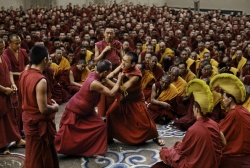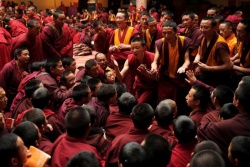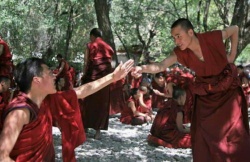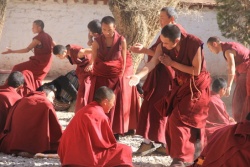Great Samyé Debate
Samye Debate, also called Council of Lhasa, in Tibetan Buddhism, a two-year debate (c. 792–794 ce) between Indian and Chinese Buddhist teachers held at Samye, the first Buddhist monastery in Tibet. The debate centred on the question of whether enlightenment (bodhi) is attained gradually through activity or suddenly and without activity.
The more conventional Mahayana Buddhist view was represented by Kamalashila, a scholar expressly called from India, and supported by the prominent Tibetan convert Gsal-shang of Dba’. They argued for the doctrine of the Madhyamika (“Middle Way”) school, which arose out of the teachings of the monk Nagarjuna (flourished 2nd century ce). According to this doctrine, the final goal of buddhahood can be achieved only after a long course of intellectual and moral development generally requiring a series of lives. The Chinese representative (whose Sanskrit name was Mahayana) upheld the teachings of the meditative Chan (Japanese: Zen) school of Mahayana Buddhism, which held that enlightenment is a sudden, spontaneous event that is not furthered and may even be hindered by conventional endeavors.
The debate took place in front of the reigning Tibetan king, Khri-srong-lde-btsan, who declared in favour of the Madhyamika teachings of the Indian representatives. His decision may have been influenced to some degree by the intermittent warfare then going on between Tibet and China. Thereafter, India exerted greater influence than China over Buddhism’s development in Tibet, though Chan continued to be respected there'
King Trisong Detsen arranged a debate in Samye to decide which of these tenets should take root in Tibet. The King invited Kamalashila to represent the Indian Buddhist school while Hva Shang Mahayana represented the Chinese Ch'an school. It is said that when Kamalashila and Hva Shang Mahayana first met in Samye, Kamalashila twirled his rosary around his finger inferring the question, "What is the source of the circling in samsara" and when Hva Shang saw that, he covered his head, indicating that "ignorance is the source of suffering." Kamalashila then felt that Hva Shang Mahayana was someone who understood.
The debate in Samye became known as the Great Debate at Samye. The rules directed that the winning side would be sanctioned by the King while the losing side would have to leave the country. Kamalashila and the Indian Buddhist School won the debate and the Ch'an Buddhists were no longer allowed to spread their teachings in Tibet. However, although Hva Shang had to leave Tibet, even up to today, in order to remember his good qualities, Tibetan monks wear a blue cord attached to their upper garment.
Also, after Hva Shang lost the debate he left immediately leaving one of his shoes behind. Tibetans believe that this was a sign that aspects of his tenets would remain in Tibet.
As a result of this debate, King Trisong Detsen asked Kamalashila to compose a text explaining the stages of meditation from the Indian Buddhist tradition. Kamalashila wrote the bsGom rim, or Stages of Meditation, in three volumes. The following is an outline of the topics in the bsGom rim bar pa.
The causes of omniscience
The stages of meditating compassion
The mind of awakening
Tranquilization and insight
Prerequisites for tranquilization
Prerequisites for insight
Preparation for a session of meditation
The practice of tranquilization
The practice of insight
The path integrating tranquilization and insight
The path integrating wisdom and method
The result of the path integrating wisdom and method



